"Let the man have been tarred with the University stick and he will tell you along with his after-dinner cigar that he has a notion of some day building a house at Chapel Hill – and there remaining to the end of the chapter in the one place where he believes he can obtain a large and perfect peace. There men cling to the town and its surroundings with a memory that is both tenacious and jealous of details.
"A friend was describing to one of these - a graduate before the [Civil] war – the site of the present Alumni Building. Suddenly the old graduate’s eyes flashed fire: “What!” he exclaimed. “You don’t tell me they’ve cut down the old college linden! I’d rather they’d have gone without that building forever than that they should have touched that tree!”
"And so it goes. Living in the hearts of its scattered children, each tree shrub and rose bush, almost each stone of its serried ranks of rough built walls, bears its own faint story; and it is the indefinable suggestion that seems in time to float out from the inanimate things that have brushed on human hopes that strangely strikes the newcomer at the moment he places foot upon the campus and brings to the returned a tingling of the blood and a half forgotten smell of the air that at once exhilarate and recall to half sad dreams of bygone days."
Gray’s argument is essentially that the landscape of Chapel Hill is a part of the experience of being young and full of life in Chapel Hill. Revisiting the landscape of your young adulthood brings back fond memories of days gone by. Or in other words, there’s nothing like walking down Franklin Street to make you feel young again, or at least bring back wonderful and powerful memories. And any change at UNC (or in Chapel Hill) detracts from that feeling. Gray is saying that the things that are new interfere with the evocation of that brief feeling of youthfulness, and you consequently dislike them.
Gray’s theory is meant to explain the experience of returning alumni, who for example are sometimes crestfallen to find that the Rathskeller is no more, or similarly are shocked to see Greenbridge rising on Chapel Hill’s western border. I am not sure that the experience is exactly the same for those who live in and near Chapel Hill and return to UNC and downtown on a regular basis, but it is at least part of that story.
Gray makes no remark on Carrboro in part because the village scarcely existed in 1904, but Carrboro is not immune to this same issue. Probably the greatest challenge facing our town is how to expand our commercial tax base without compromising the sense of place that is Carrboro. And I suppose such things are challenges for any community, but I think Gray is suggesting that this phenomenon is especially strong in Chapel Hill because so many people discover the town as 18-year-olds, entering the prime of life and for the first time living with new found freedom. This is true for Carrboro as well, although somewhat less so because Carrboro is less a part of the undergraduate experience for most students.
It is also interesting to note that Gray mentions that a part of this phenomenon is that the critic of change “has a notion of some day building a house at Chapel Hill.” Gray does not remark upon the irony of the critic at once lamenting any change to the Chapel Hill landscape and expressing his desire to change that same landscape by building his own house there. No doubt the critic feels that although change in Chapel Hill is bad, just one more house won’t hurt, as long as it is his.
From today’s vantage point, it also seems ironic that the critic would lament the construction of Alumni Hall:
Alumni Hall is in fact one of the buildings that gives secondary definition to McCorkle Place and has many beautiful architectural details. That anti-Alumni Hall sentiment seems particularly ironic in light of Davie Hall, which UNC went on to build only 200 yards away: 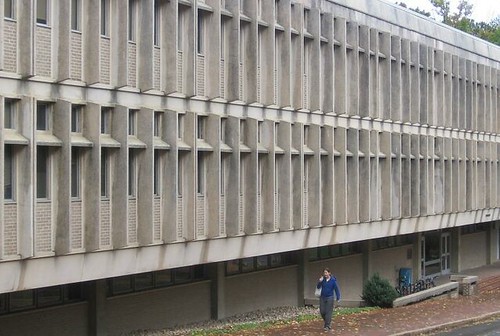
The desire to return to a Chapel Hill that was known from earlier days goes still further back in UNC's history. William D. Moseley, a member of the UNC class of 1818, wrote a letter to his former professor Elisha Mitchell in 1853: “I know of no earthly pleasure which would afford me more heartfelt satisfaction than a short stay at that village [Chapel Hill]; where I could again refresh my memory with a review of the places and things that still remain as mementos of days that are past; when the future was looked to with hopes, never to be realized.”
At some level, none of this is lost on either the administration of the University or the government of the Town, for both have sometimes made wise choices about the preservation of the historical landscape. Among Moseley’s other comments in his 1853 letter: “I would like too to visit the Old Poplar, in the right of the path leading from the Chapel to Dr Caldwell's. Is it still living?” Not only was it still living in 1853, but it is still living today:
Moseley’s letter indicates that the Davie Poplar was a noted landmark even when the University was young. And clearly it was called “the Old Poplar” even by members of the class of 1818. It was already at least 100 years old when Moseley graduated. The Davie Poplar is now at least 300 years old and some think it may be approaching 400.
But nothing in this world lasts forever, and UNC began preparing for the inevitable about 90 years ago by grafting a cutting of the Davie Poplar to create Davie Poplar, Jr., which grows in the shadows of the original. And more recently a seedling of the Davie Poplar was cultivated and planted nearby with the appellation Davie Poplar, III. It's right in front of Alumni Hall as it happens. While obviously no one is hoping for the day when the Davie Poplar falls, it is reassuring to know that UNC has long since begun to prepare for that day.
Likewise, no one hopes for the day when our community will face dramatic changes brought about by greenhouse gasses as well as the ever-increasing cost (and ever-decreasing supply) of petroleum. But we cannot bury our heads in the sand and hope that such challenges will never come. They will come and we all know it. At the local level, Carrboro, UNC and Chapel Hill can make only the most incremental changes to the composition of the atmosphere or the supply of available petroleum. But we can and we must prepare for the future that we know is coming.
Preparing for a world with fewer cars and less petroleum will partly involve technological breakthroughs in sustainable energy, but it must also involve dramatic improvements in energy efficiency. And one way for us to reduce our society’s demand for energy - a way that is entirely within the control of local government in North Carolina - is to change our built landscape – to create a more pedestrian, bicycle and transit friendly landscape. And that will involve a more compact form of development, focused on key transportation corridors.
One area that is appropriate for the new landscape that our community will need is the NC 54 corridor between Meadowmont and UNC, along the planned route of the Triangle’s light-rail system. Downtown Carrboro and downtown Chapel Hill are also areas where outstanding public transportation is already readily available and are appropriate places for more intense development. Yet, the importance of the landscape, the sense of place in these locations cannot be ignored.
How would Carrboro be Carrboro without these buildings:
On the other hand, some downtown Carrboro buildings seem considerably less essential: 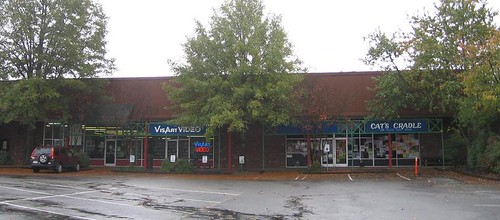
To be clear these businesses are essential, but the buildings are not.
Likewise, the Best Western University Inn
was a pretty unremarkable building. The grassy areas out front were pleasant, but it was mostly a low utilitarian building with a sea of asphalt in front. The picture above was taken as a publicity photo and it still makes the building and lot look unremarkable (at best). East54's critics only ever acknowledge this reality when prompted to do so. Likewise there seems to be no public acknowledgement that the site of Greenbridge was not long ago a flophouse for crack dealers. Does any of this mean that East54, Greenbridge or 300 E. Main Street will be perfect? Of course not. But let’s be clear, what they are replacing was not so terrific as some would like to pretend.
Change is inevitable for Carrboro and Chapel Hill. The challenge is to keep the elements that are central to our landscape from the past, while creating a more energy-efficient and pedestrian friendly landscape for the future. Personally, I think that is something that Carrboro, UNC and Chapel Hill can do.
Cross-posted from my history blog: http://piedmontwanderings.blogspot.com/
Issues:

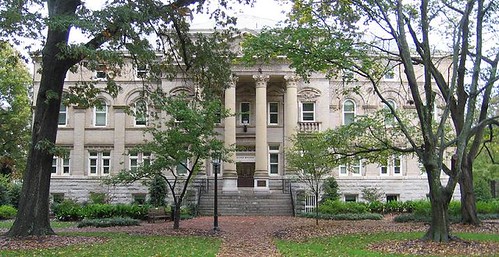
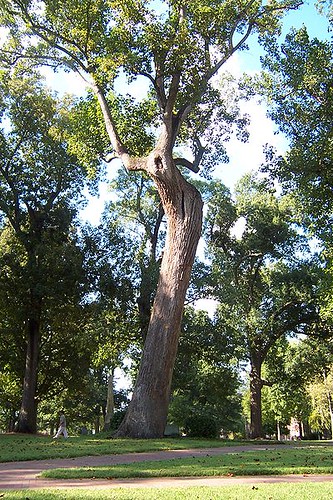
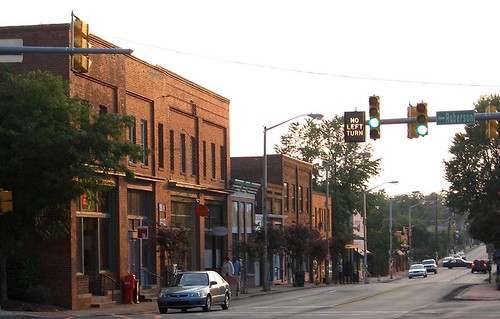
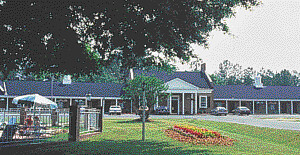


Comments
Thanks Mark
for putting the ongoing discussion of change into a truly historical perspective. That was a very pleasant and informative read.
Our communities are a work in progress
and we learn as we tackle the tough challenges, knowing that we don't have all the answers, and not being paralyzed because of that. Excellent perspective piece, Mark.
Ditto
Lovely and thanks.
Thanks Mark
Great reading.
Really interesting, Mark.
Really interesting, Mark. Thanks.
my dad shocked at changes on the Hill from 1943 to 1967
The first thing I ever saw in Chapel Hill was the Best Western University Inn (it was the University Motor Hotel at the time). My father brought my from Hartford in July of 1967 for an admissions interview at Carolina. We checked in at the University Motor Hotel and went on up to campus for my interview. I do not miss the demolition of the University Inn one bit, 54 East is far better looking. Apropos of Mark's point, my father was SHOCKED at all the changes in Chapel Hill from February of 1943 when the Army drafted him and he had to pack his bags and leave Chapel Hill. He returned for one day in 1946 to return to classes but could not find housing and did not return again until the trip with me in 1967. As for myself, I functionally left in 1984 (though I was in grad school part time 2002-2004 and was on the Hill a lot but commuted from Raleigh one class per semester) and the changes 1984 to 2002 startled me. During that 18 year period I was in Chapel Hill once a year at most. I've always liked whatever Chapel Hill was like the day I was there, whether 1967, 1968-1984, or 2009.
More than the eye can behold
Mark, thank you for a lovely piece of writing and history.Let us not ignore that there is good and bad change. First, I don't accept as given that there will be light rail in Chapel Hill, NOR that is move along the NC 54 corridor. The interesting thing about trains is that they do not have to follow established paths of transit. Thus, their primary function is destination to destination delivery. That said, the personal conveyance we now enjoy through petroleum will be powered someday by another sourse fuel (likely solar), and traffic on surface roads will remain an issue. You can't build trains to serve all destinations.Second, since change is inevitable people ought to have a right to decide what that change should be in a democratic community. As a current example, East54 provides housing and commercial space. But do all future developments have to follow that lead? Aren't there already ample residential communities that NEED proximal (i.e. walkable/bikable) commercial hubs? And what type of housing needs creating? Is 15% affordable enough to demand when a developer is given the privilege of cashing in on the Chapel Hill legacy? Perhaps 70% affordable is a more appropriate number?Finally, a town should identify the core features (principals) it desires to foster and protect as essential characteristics of itself. Thus, the Chapel Hill Comprehensive Plan specified building heights, set backs, maintenance of grassy vistas (think Meadowmont as kept, University Best Western as lost), water and tree protection as examples. These principals are necessary to guide decision-making over time. Without them, a town can quickly become one long strip mall and office complex after another.I understand the nostalgia that undergirds abhoring change. But perhaps the subtext of some of the laments you quote have more to do with a core principal that was violated. Whats on the surface of a comment is not always the source of its utterance. Early Monday thoughts.Henry Lister
light rail/expanded bus organizing begins Wednesday night
drhalister says
There is certainly no given that there will be light rail to Chapel Hill, but if it does come that is where it will enter -- the corridors are reserved, through Meadowmont and behind 54East, and entering campus near Manning Drive and behind the Smith Center to the Dogwood Deck behind UNC Hospitals -- that is the corridor the University has reserved for the LRT line. Thos who are interested in working on this project, the local effort begins Wednesday, starting the process for a three county referendum in 2010 or 2011.http://www.durhamorangefriendsoftransit.orgLET'S GET ORGANIZED!Come join us to build a grass roots organization for transitNovember 4, 2009, 6:45 PM untilat the Eno River UU Fellowship 4907 Garrett Road in Durham http://www.eruuf.org/contact-us/directions-and-parking6:45 to 7:30 is small group resource sessions with "experts", 7:30 to 8:30 speechifying from experts and community leaders, then breakout sessions and wrap up.come participate! I will post more details in a transit thread today or Tuesday unless GeorgeC beats me to it.
Yes and no
"Finally, a town should identify the core features (principals) it desires to foster and protect as essential characteristics of itself."Absolutely, Henry, although I am not sure that I would agree that "building heights, set backs" are as good of examples as "maintenance of grassy vistas" of principles. Clearly, it is for the people of Chapel Hill to decide (along 54) and "maintenance of grassy vistas" was one of the things that Joyce Brown and I fought hard for with Meadowmont (some say mistakenly).In any case, basically you are right on target in suggesting that we do not need strip mall hell to spread out along NC Hwy 54. East54 may not be just the right answer, but I would venture that it is a major departure from the kind of low retail buildings separated from 54 by large parking lots and essentially unassailable for pedestrians (such as Glen Lennox Shopping Center). And I think departing from that old model is good. If East54 is not quite right either, then let's keep working on the problem.Also, the Glen Lennox Apartments are a great example of the debatability of what is or is not important to Chapel Hill's sense of place and history. Some see them as vital, others are ready to see them go. That is something that Chapel Hill will have to sort out for itself.Also, Gerry is clearly correct - if light rail comes, then it will come on 54. But even if light rail never comes, we did reserve right of way through Meadowmont that would allow for Bus Rapid Transit or other less capitol intensive rubber-tire public transportation between UNC and Durham - and I personally think that some version of such a system will have to happen somehow sometime. Either that or there will have to be some massive changes in housing arrangements, because right now there are already way too many people trying to get between here and Durham (both directions). And I reckon you would agree that more lanes and more cars are not the solution.Good to hear from you, Henry!
Landscape and Memory is spot on
Wow, what an interesting article from 1904. Its exactly spot on, as it seems you can't even build on an empty lot in Chapel Hill without someone getting nostalgic. The reaction to East 54 is interesting in its intensity, as I can't figure out what people want instead. Most of the anti-East54 talk seems to describe a strip mall as what they'd prefer, and yet for me at least low density commerce like you get on the way from 15/501 into Durham is pure hell. I wonder if any of the citizens have actually read and understood the long-range development plan in Chapel Hill, which has as its goal preserving parts of town and surrounding area as low density while concentrating density along transportation corridors.
Great stuff, Mark
Deja vu all over again.
Carrboro: From Forest to Mill Village and Beyond
Mark has posted a much longer version of this that he presented at UNC Geography Department's Spring Colloquium. Do check it out at: http://piedmontwanderings.blogspot.com/2010/01/i-would-like-to-begin-by-...A fantastic read for anyone interested in this community, our physical/geographic history, and where we might be going.